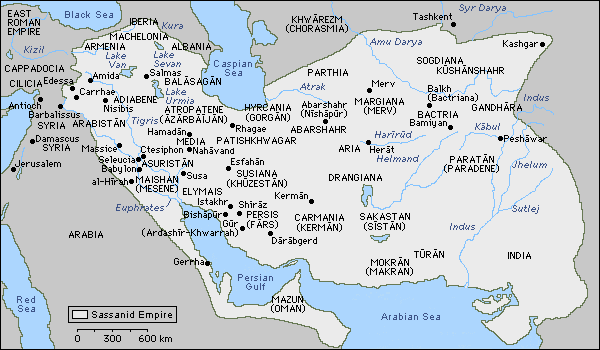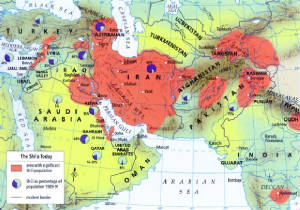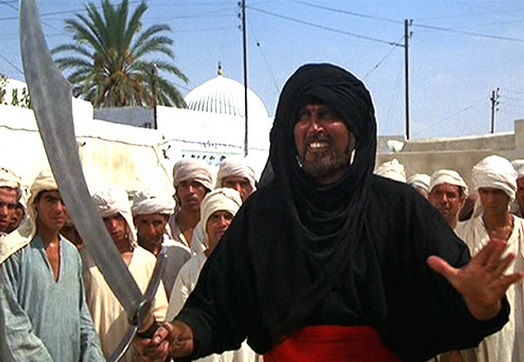Ayatollah Mohammed Bagher Kharrazi's call for a Greater Iran encompassing "the entire Middle East and Central Asia"
has caused a veritable epidemic of Internet hyperventilating among the armchair alarmist eschatologists, many
of whom are living proof that "a little learning is a dangerous thing." Allow me to correct some
of the more glaring inaccuracies and provide a modicum of informed analysis:
1) The Islamic Republic of Iran
is NOT enamored of (re)creating a caliphate.
The Caliphate--that historical redoubt of
SUNNI Muslim institutional authority and power, from the Umayyads to the Ottomans--is the LAST thing that any ayatollah
in Tehran or Qom wants. Rather, the Twelver Shi`is of Iran (as well as Iraq, Lebanon, and other concentrations throughout
the region) look for the restoration of the Imamate--a ruling office inhabited by one of Muhammad's bloodline through his
son-in-law, and cousin, Ali passed through the latter's sons. The Sunni caliphs were, rather, chosen
by
ijma` or "consensus" of the Sunni communal leadership. The import for any Pan-Islamic geopolitical
movement today is that there seems to be an unbridgeable gulf between Sunni caliphal dreams, which are based on some element
of popular legitimacy, on the one hand, and Shi`i hopes for an imamate, on the other, which in its true form would require
the return of the Mahdi, the Twelfth Imam and in his absence appears dependent on the continuation (and perhaps expansion,
as Kharrazi implied) of clerical rule under the extant
vilayet-i faqih. And both ayatollahocracy and Mahdiyah
are, by definition, elitist and nondemocratic in the extreme.
2) Kharrazi is not so much a "hard-liner"
or "extremist" as he is an irredentist.
Western journalists and analysts really should learn
not to throw around terms like "hard-liner" and "extremist" in contexts where they are entirely inappropriate.
(But of course that would require some actual in-depth knowledge of the relevant subject matter--but I digress.) Article after
article commenting on this "Greater Iran" idea labels Kharrazi "radical," "extremist," "hard-liner,"
etc. He's actually an
irredentist--that is, he looks backward into Iranian history and sees that in the past
his country was much greater in size than it is today and supports re-uniting those long-sundered regions. Unlike many
Arabs, Iranians are quite proud of their pre-Islamic civilization and the political empires it created, which were important
on not just a regional but a world scale in ancient times. When Kharrazi speaks of an Iranian Islamic state "from
Afghanistan to Israel" he probably has in mind the pre-Islamic Sassanian Empire for its rough borders:

The Sassian Empire lasted from the third century AD to the Islamic conquest in the mid-7th century AD and was, in the
time it existed, an inveterate foe of the Roman/Byzantine Empire. At certain times Sassanian power even extended to the Mediterranean,
as the empire sometimes managed to pry Syria and what is now Israel/Palestine away from Roman control. When
Kharrazi dreams of Greater Iran from the Med to the Oxus, this is most likely his template.
(Some of my colleagues
might argue Kharrazi has in mind the Abbasid Caliphate, 750-1258 AD, but there are significant problems adducing
this state in this context: a) the Abbasid empire, while heavily Persian in origins and bureaucracy, was not Iranian
per se; b) neither was it really ever Shi`i, early propaganda claims notwithstanding; and c) its geographical
extent included North Africa, Egypt and the Arabian peninsula, putting it outside Kharrazi's described area and including
too many Arabs at the expense of the states and groups to Iran's north and east who are ethno-linguistically closer to
the Iranians, such as Tajiks, Uzbeks, Turkmens, Afghans, et al.
For these reasons I think the Sassanian state is
more likely his model.)
3) Islamizing and eschatologizing geopolitics.
Kharrazi's irredentist nationalism
is also heavily informed by his Twelver Shi`i beliefs and while Iran and Iraq are the only majority-Twelver states, there
are significant populations of Twelver (and Sevener, or Isma'ili) Shi`is "from Afghanistan to Israel" (the red zones
on this map):

As per my first point above, any Pan-Islamic state centered on Iran would be better off trying to encompass as many
Shi`is as possible, which a Med-to-Hindu-Kush strategy does rather well; furthermore, since said polity is
envisioned as "a prelude to the reappearance" and, eventually, "the single global rule of the Mahdi"
then the more Shi`is, the better (since Mahdist belief is more institutionalized, if not always more fervent, in Shi`ism than
in Sunnism).
4)
Shi`ism's "preferential option for the poor," which appeals
to the Western Left.
Kharrazi's phrase that the "Islamic United States" will constitute "the
global village of the oppressed" is easily missed, and when it is noted is passed off as a cynical attempt to garner
support from Western liberals. But Shi`ism, especially in its view of the Mahdi who upon his return will serve as a
global Robin Hood (taking from the
mostakbaran, the "rich," and giving to the
mostazafan, the
"oppressed), has a long tradition of supporting socioeconomic "justice," which has sharpened since the revolution
there and been wielded by Khomeini and his successors--most notably, Ahmadinezhad--as a weapon against "arrogant powers"
such as the U.S. and as a means of enlisting the support of leaders such as Hugo Chavez who buy into (either honestly or cynically)
a global conflict between the haves and the have-nots.
